
 |
The dreadful massacre
which was the First World War finally came to an end in 1918, it will be
observed that carved above the Ruyton XI Towns War Memorial are the years 1914-1919. This is because, although the Armistice was
signed on 11th November 1918, the final Paris Peace Conference took place at Versailles
on 28th June 1919.
Interestingly,
Canon Edge, Vicar of West Felton and author of The History of that village, was
at a meeting of the Classical Association in Manchester when he heard about the
Imperial Conference which took place in 1918 at which Sir Frederic George
Kenyon was present. Sir Frederic was grandson of Thomas and Charlotte Kenyon of
Pradoe, Director of the British Museum and President of the British School of
Archaeology in Jerusalem, with a particular interest, among other things, in
ancient monuments. It had been a concern
in high places, about what would be done about war cemeteries after the war,
when Sir Frederic reminded the committee that in 5th century Athens
war dead were listed in war cemeteries with just their names being carved in
stone with the Tribe, or regiment, to which they belonged. The Committee accepted the Athenians way of
recording the dead and so we have a Kenyon to thank that, wherever the war dead
are buried, each has an identical headstone with no distinction for wealth or
service hierarchy.
An example of
exactly what Kenyon wanted to avoid can be seen in Little Ness churchyard where
Maurice Darbv, son of Arthur and Frederica Darby of Adcote House, has a very
ornate monument recording that his uncle, Sir George Arthur, had searched the
battlefield until he found his nephew, four days after his death and brought
his remains home to be buried with other members of his family. The young man
was one of the very few Englishmen killed on the Western Front to be
re-patriated. The other 20 men from the village who fell, just had their names
recorded on the War Memorial.
As men from Ruyton
were declared dead or missing, the obvious place to make a shrine was the
village Cross, but this was a temporary measure. On 24th April 1919 a public
meeting was held to decide on `A scheme for the Memorial to the Soldier and
Sailor Heros of the Parish who have fallen`. A committee of 20 was elected and ideas for a
Memorial were submitted – the contender of two German captured guns and a
plaque with names of the fallen was dismissed as disrespectful. Another idea, to add a bit more to the Cross
with names round the bottom was thought unworthy. A 14ft cross in the garden of the Victoria Room
was deemed to be subject to wind and erosion.
However, Mr. William David Briscoe, threshing machine owner, well sinker
and general engineer, of Rock Cottage, Brownhill offered a piece of land beneath
his property to serve as a site for the proposed memorial, and this was
accepted.
Mr. Stanley
Vaughan of London was engaged to design the War Memorial exactly as we see it
today, except, that it was to have a hole cut above for a shaft of light to
shine on the cross at the back. The
names of the fallen were to be inscribed on a ceramic plaque made by the
Potters Guild of Guildford.
Two stone masons
quoted for the work, Mr. John Howells, £25, and Warwick Edwards, who won the
quote at just £10. However, Mr. Edwards and his son had to contend with the vagaries
of Ruyton sandstone which has a mind of its own, and a fault in the stone meant
extra cutting was required to find a solid surface. Also, the idea of a hole
for the sun to shine through had to be abandoned.
A total of £94 13 shillings
and 3pence had been collected to cover the costs; £16 7shillings for the architect,
£12 for the Potters Guild and £42 14shillings for Warwick Edwards and his son
Leonard. Even at the time, the memorial was
considered unique in the country.
The Memorial was
unveiled and dedicated on Sunday 10th October 1920. Parishioners and most of the village met at
the village cross and proceeded to the parish church, led by the school
children carrying flowers and Comrades of the Great War. The United service was led by the Vicar, Rev.
Craven, and Mr. T.B. Evans, Congregational Minister read the lesson. Mr. W.A.
Riddlesworth presided at the organ. The
congregation then proceeded to the War Memorial where General Edward Ranulph Kenyon
C.B. delivered the address.
Who owns the
War Memorial?
As part of the
lead up to the Charter celebrations in 2008, an attempt was made to discover
the owner of Ruyton XI Towns War Memorial.
John Hamlett of The Marches had been left Rock Cottage by his
grandmother and he demolished the building to sell the site to a developer who
built Rock House and High Bank. John had wished to donate the War Memorial to
the village, but his solicitors Longueville Gittins, discovered the land was
owned by Mrs. Watson who had lived in a wooden hut across the road until she
died about 20 years previously. The
developer who had bought the site of Rock Cottage also bought the site of Mrs.Watson`s
bungalow and built Riverbank House.
It is most
unlikely that Mrs. Watson or her father before her, had ever owned a piece of
rock on the opposite side of the road. John
Hamlett`s mother, Margaret Hamlett, who had lived on the Brownhill all her
life, said the site of the wooden hut had been given to Mrs.Watson`s father who
was a cripple from World War I, and Dame Agnes Hunt gave him one of the wooden
staff huts from Baschurch when she moved her hospital to Gobowen. When Mr. Jones was measuring up to sell Afon
Cottage next door, Mrs. Watson`s father tried to claim more land for himself
but Mr. Jones pointed out he had given the land for the hut in the first place so
he would put his boundary where he wished.
At a Charter
committee meeting in January 2005, Mrs. Avril Sanders-Royle of Rock House said
her deeds indicated her land extended to the road, so she kindly took it upon
herself to keep the war memorial clean and tidy and regularly furnished it with
flowering plants.
Listing the
War Memorial
In 2005, Yoland
approached Clive Blakeway, Shropshire representative of the War Memorial`s
Trust with a view to getting our memorial listed by English Heritage. With the backing of Oswestry Conservation
Officer, and the work of Clive in filling in endless forms, our War Memorial
was granted Grade II listing on 15th December 2005. The English Heritage Advisors report said it
was an unusual war memorial, the only other similar was in Bamburgh but that
was not a cave. “It is carved out of
a 30ft red sandstone cliff, and forms a cave approximately 8ft deep, 10ft high
and 8ft wide. Although this war
memorial does not exhibit a high level of sculptural quality, its design in the
form of a cave is of a very rare type and is of clear local as well at
national, historical and architectural significance”.
The dates, 1914 –
1919 above the Memorial are very worn but it was decided not to look into
recutting the dates as the cost of scaffolding and traffic lights would be
prohibitive.
Irena White has
done extensive research on the Ruyton men who never came home and is now
negotiating with the Parish Council to get the names of the three men whose names were missed off the
list to be added, Charles Henry Hanmer, Ernest Lloyd and Alfred Rogers. One man is on the war memorial is Benjamin
Jones but he and the missing Ernest Lloyd both died on their return, possibly
from wounds, and have official headstones in the churchyard.
Irena and her late
husband, Leslie, also researched all 110 men over 21 from this village who
joined up. The war memorial records 130 men but that includes under 21s, and
probably those who lied about their age and were even younger. It
is amazing how many men marched away
leaving Ruyton a community of women, children and old men for 5 long
years. Of the 934 people living in the Parish, all
would have known a father, brother, uncle, cousin or
neighbour listed on our War Memorial.
Thankfully only 5
men are listed as having given their lives in the Second World War.
So, do please take a good look at our unique War Memorial, the only one of its kind in the country and, it did not take an expensive outside sculptor to carve it but our own Warwick Edwards and his son Leonard.
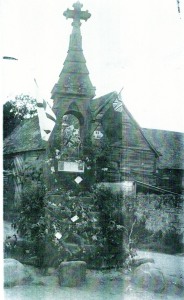 |
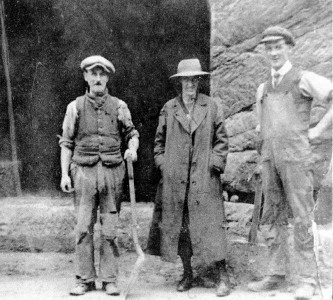 |
Ruyton XI Towns War Memorial
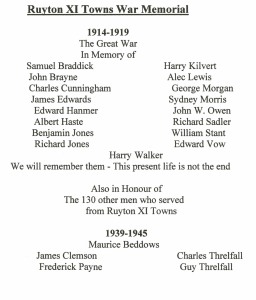 |
| The Cross being used as a temporary War Memorial |
Warwick Edwards, his wife Alice and son, Leonard |
|
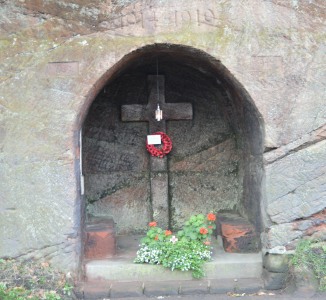
|
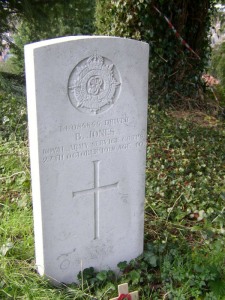 |
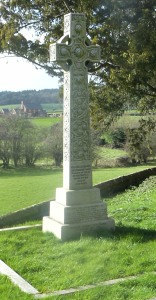 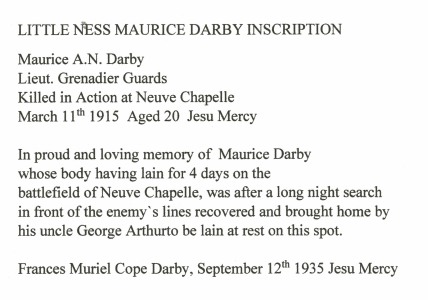
|
| Our War Memorial photographed by Peter Evans |
Standard headstone, thanks to Kenyon Sir Frederick George Kenyon B. Jones 27th April 1918 in our churchyard |
Maurice Darby memorial in Little Ness Churchyard - just the sort of personalised memorial Sir Frederick Kenyon wanted to avoid |